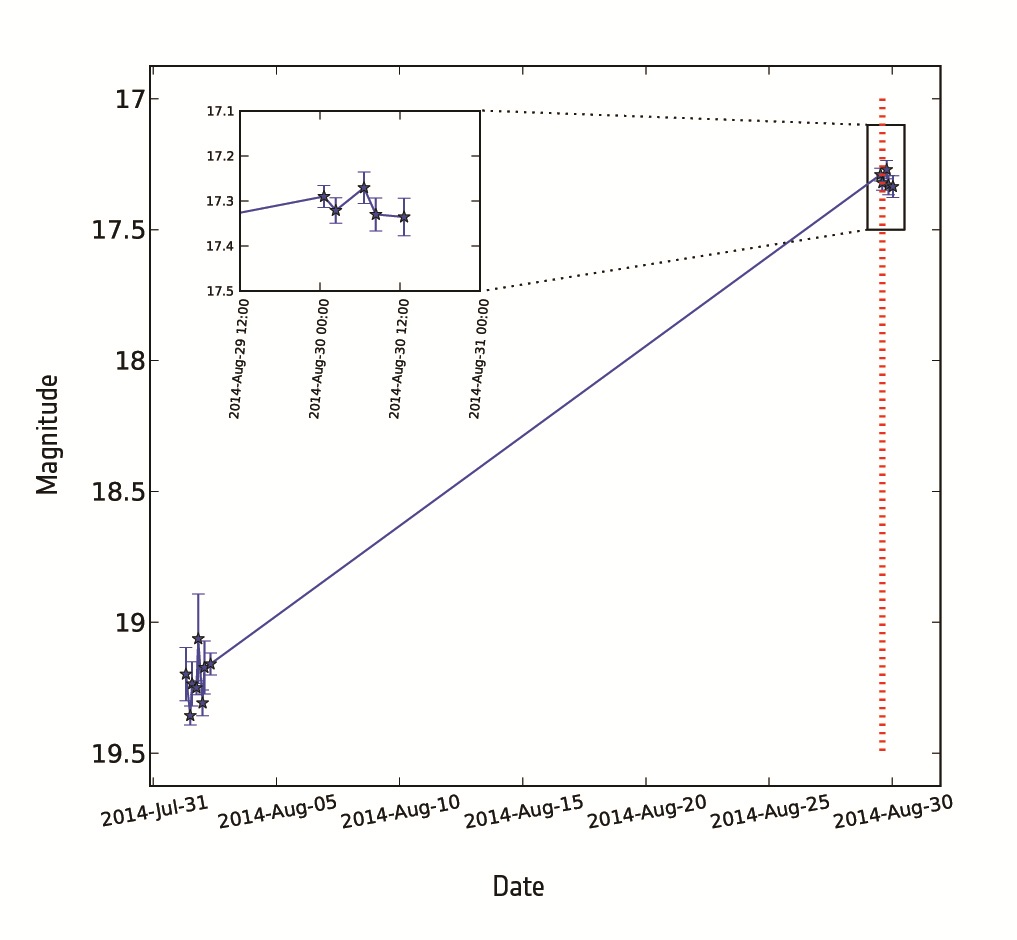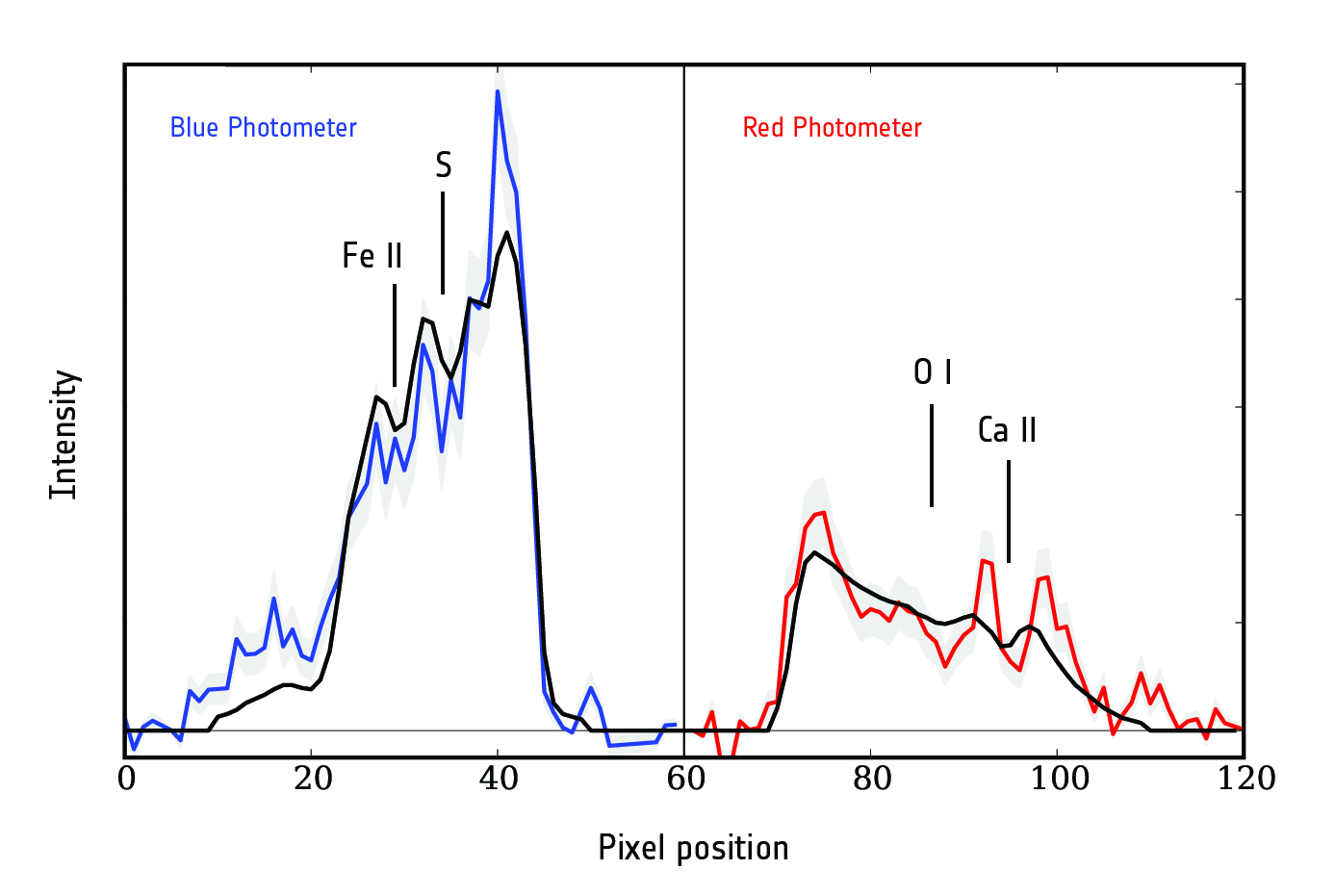IoW_20140912 - Gaia
Image of the Week |
Gaia Discovers its first supernova |
 |
|
Light curve of galaxy SDSS J132102.26+453223.8 obtained with Gaia. It shows the evolution in time of the galaxy's brightness. The brightness is indicated on the vertical axis; smaller magnitude values indicate a brighter source. The light curve shows how the galaxy significantly brightened up between the two consecutive Gaia observations because of a stellar explosion, or supernova, which was named Gaia14aaa. This is the first supernova discovered with Gaia. The data points and error bars at the lower left corner are from the first observation, performed on 31 July 2014, and they are in line with previous observations of the same galaxy performed with other telescopes. The data points at the upper right corner are from the second observation, performed on 30 August 2014, and reveal a sudden rise in brightness of almost two magnitudes (roughly a factor of 6). Using data from Gaia and other telescopes, astronomers confirmed that Gaia14aaa is a Type Ia supernova, the explosion of a white dwarf caused by the accretion of matter from a companion star in a binary system. credits: ESA/Gaia/DPAC/Z. Kostrzewa-Rutkowska (Warsaw University Astronomical Observatory) & G. Rixon (Institute of Astronomy, Cambridge) |
| Supernova Gaia14aaa and its host galaxy |
|
This image shows the supernova named Gaia14aaa as seen on 10 September 2014 with the robotic Liverpool Telescope on La Palma, in the Canary Islands, Spain. This is a Type Ia supernova – the explosion of a white dwarf locked in a binary system with a companion star – and it was discovered in the data collected with ESA's Gaia satellite on 30 August. In the left panel, the image from the Liverpool Telescope shows both Gaia14aaa and its host galaxy, named SDSS J132102.26+453223.8, which is about 500 million light-years away. In this image, the supernova is slightly offset from the galaxy's core. The central panel shows an image of the same galaxy, taken as part of the Sloan Digital Sky Survey, several years before the explosion of Gaia14aaa could be observed from Earth. The right panel was obtained by subtracting the second image, which contains the light emitted by the galaxy, from the first one, which depicts both the galaxy and the supernova. The difference between the two images clearly shows the appearance of Gaia14aaa. The image was taken using the i' filter, which corresponds to red and near-infrared wavelengths. credits: M. Fraser/S. Hodgkin/L. Wyrzykowski/H. Campbell/N. Blagorodnova/Z. Kostrzewa-Rutkowska/Liverpool Telescope/SDSS |
| Gaia spectrum of supernova Gaia14aaa |
 |
|
Low-resolution spectrum obtained with the photometric instrument on Gaia of a stellar explosion, or supernova. Astronomers using Gaia discovered that a source had significantly brightened up between two consecutive observations, performed on 31 July 2014 and 30 August 2014, respectively. The boost in brightness was caused by a supernova, which was named Gaia14aaa. This is the first supernova discovered with Gaia. The photometric instrument splits the light of an astronomical source to create a spectrum. In fact, Gaia uses two prisms spanning red and blue wavelength regions to produce a low-resolution spectrum that allows astronomers to seek signatures of the various chemical elements present in the source of that light. Light from the blue photometer is shown in the left half of the graph, and that from the red photometer in the right half. On the horizontal axis, the position of pixels in each of the two photometers is indicated. The pixel position provides a rough indication of the wavelength, with the blue photometer receiving light with shorter wavelengths (330–680 nanometres), and the red photometer with longer wavelengths (640–1050 nanometres). On the vertical axis, the intensity of light registered at each pixel is indicated. The gap at the centre of the graph is an instrumental effect. The black curve is the best fit model for SN Ia, provided by the Bp/Rp classification code GS-TEC (Gaia Spectrophotometry- Transient Event Classifier). The comparison with the SN models in the classification code allowed the researchers to identify this supernova with Gaia data only. It helped to predict its type, its redshift and epoch before having the ground-based verification high resolution spectra for it. The Bp/Rp information was the key in this case to confirm this first candidate (triggered by its lightcurve), as a valid SN. This low-resolution spectrum contains hints about the nature of this transient source. The blue part of the spectrum appears significantly brighter than the red one, as expected from a supernova of Type Ia – the explosion of a white dwarf caused by the accretion of matter from a companion star in a binary system. The presence of absorption lines from iron, sulphur, oxygen and calcium (indicated in the graph) is also in line with the elements expected from a Type Ia supernova. The astronomers followed up this source with the Isaac Newton Telescope on La Palma, in the Canary Islands, Spain, obtaining a high-resolution spectrum. This not only confirmed that the explosion corresponds to a Type Ia supernova, but also provided an estimate of its distance, proving that it actually happened in the galaxy where it was observed. credits: ESA/Gaia/DPAC/N. Blagorodnova, M. Fraser, H. Campbell, A. Hall (Institute of Astronomy, Cambridge) |
|
Read more about Gaia's first supernova discovery here. |
|
[Published: 12/09/2014] |
- Removed a total of (7) style text-align:center;
- Removed a total of (3) style text-align:left;
- Removed a total of (7) style text-align:justify;
- Removed a total of (1) border attribute.
- Removed a total of (1) cellpadding attribute.
- Removed a total of (1) cellspacing attribute.
Image of the Week Archive
- Removed a total of (1) border attribute.
- Removed a total of (1) cellpadding attribute.
- Removed a total of (1) cellspacing attribute.








































 Sign in
Sign in
 Science & Technology
Science & Technology

